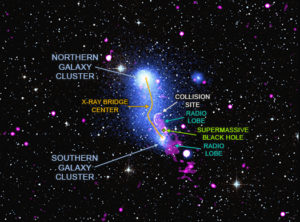
A new study, based on data from the European Space Agency’s (ESA) XMM-Newton and NASA’s Chandra X-ray observatories, sheds new light on a three million light-year long bridge of hot gas linking two galaxy clusters, whose shape is being bent by the mighty activity of a nearby supermassive black hole.
Galaxy clusters are the largest objects in the Universe held together by gravity. They contain hundreds or thousands of galaxies, vast amounts of multi-million-degree gas that shines brightly in X-rays, and enormous reservoirs of unseen dark matter.
The system portrayed in these images, called Abell 2384, is located 1.2 billion light years from Earth and comprises an overall mass of over 260 trillion times the mass of the Sun. In this case, the two galaxy clusters collided and then passed through each other, releasing a flood of hot gas from each cluster that formed an unusual bridge between the two objects.
The X-ray view from XMM-Newton and Chandra is shown in blue, alongside observations in radio waves performed with the Giant Metrewave Radio Telescope in India (shown in red) and optical data from the Digitized Sky Survey (shown in yellow). The new multi-wavelength view reveals the effects of a jet shooting away from a supermassive black hole in the center of a galaxy in one of the clusters.
The jet is so powerful that it is bending the shape of the gas bridge, which has a mass equivalent to about six trillion Suns. At the collision site, where the jet is pushing the hot gas in the bridge, astronomers found evidence for a shock front, similar to a sonic boom from a supersonic aircraft, which can keep the gas hot and prevent it from cooling to form new stars.
Objects like Abell 2384 are important for astronomers to understand the growth of galaxy clusters.
Computer simulations indicate that, after such a collision, galaxy clusters oscillate like a pendulum and pass through each other several times before merging to form a larger cluster. Based on these simulations, astronomers think that the two clusters in this system will eventually merge.
The study describing this work, led by Viral Parekh of the South African Radio Astronomy Observatory and Rhodes University, South Africa, was published in Monthly Notices of the Royal Astronomical Society in January.
This article was posted on 1 May 2020.





